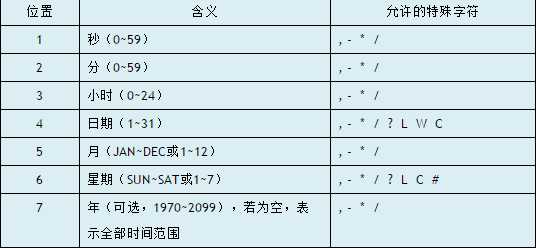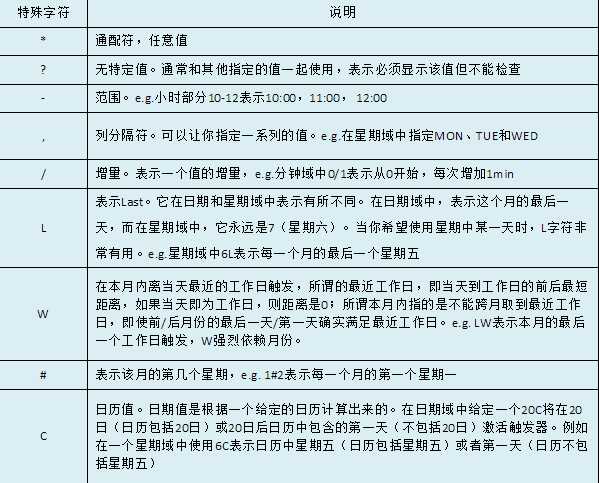Spring框架中的Quartz使用(详解)Spring框架中的Quartz使用:首先简单介绍下Quartz,它是一个完全由Java编写的开源作业调度框架,为在Java应用程序中进行作业调度提供了简单却强大的机制,相当于java.util.Timer,但是比Timer多了很多的功能:1.持久性作业,就是保持调度定时的状态;2.作业管理,对调度作业进行有效的管理;3.类Corn的定时支持,可以用Corn的方式来执行作业;4
Spring框架中的Quartz使用:
首先简单介绍下Quartz,它是一个完全由Java编写的开源作业调度框架,为在Java应用程序中进行作业调度提供了简单却强大的机制,相当于java.util.Timer,但是比Timer多了很多的功能:
1.持久性作业,就是保持调度定时的状态;
2.作业管理,对调度作业进行有效的管理;
3.类Corn的定时支持,可以用Corn的方式来执行作业;
4.线程处理模型 Timer是单线程作业的,但是Quartz支持线程缓冲池。
在Spring中可以很方便的使用Quartz来实现定时任务等功能,我先介绍一下不使用Spring的Quartz实现,主要就是讲解Schedule(任务调度器),Job(作业任务)和Trigger(触发器)三者的关系。具体的体系结构从网上copy过来,讲的比较详细:
●Job:是一个接口,只有一个方法void execute(JobExecutionContext context),开发者实现该接口定义运行任务,JobExecutionContext类提供了调度上下文的各种信息。
●JobDetail:Quartz在每次执行Job时,都重新创建一个Job实例,所以它不直接接受一个Job的实例,相反它接收一个Job实现类,以便运行时通过newInstance()的反射机制实例化Job。因此需要通过一个类来描述Job的实现类及其它相关的静态信息,如Job名字、描述、关联监听器等信息,JobDetail承担了这一角色。
●Trigger:是一个类,描述触发Job执行的时间触发规则。主要有SimpleTrigger和CronTrigger这两个子类。当仅需触发一次或者以固定时间间隔周期执行,SimpleTrigger是最适合的选择;而CronTrigger则可以通过Cron表达式定义出各种复杂时间规则的调度方案:如每早晨9:00执行,周一、周三、周五下午5:00执行等。
●Scheduler:代表一个Quartz的独立运行容器,Trigger和JobDetail可以注册到Scheduler中,两者在Scheduler中拥有各自的组及名称,组及名称是Scheduler查找定位容器中某一对象的依据,Trigger的组及名称必须唯一,JobDetail的组和名称也必须唯一(但可以和Trigger的组和名称相同,因为它们是不同类型的)。Scheduler定义了多个接口方法,允许外部通过组及名称访问和控制容器中Trigger和JobDetail。
Scheduler可以将Trigger绑定到某一JobDetail中,这样当Trigger触发时,对应的Job就被执行。一个Job可以对应多个Trigger,但一个Trigger只能对应一个Job。可以通过SchedulerFactory创建一个Scheduler实例。Scheduler拥有一个SchedulerContext,它类似于ServletContext,保存着Scheduler上下文信息,Job和Trigger都可以访问SchedulerContext内的信息。SchedulerContext内部通过一个Map,以键值对的方式维护这些上下文数据,SchedulerContext为保存和获取数据提供了多个put()和getXxx()的方法。可以通过Scheduler# getContext()获取对应的SchedulerContext实例。
下面简单的helloword代码感受一下Quartz的工作流程:
- package quartz;
-
- import java.util.Date;
-
- import org.quartz.Job;
- import org.quartz.JobExecutionContext;
- import org.quartz.JobExecutionException;
-
- public class HelloWord implements Job{
-
-
- public void execute(JobExecutionContext arg0) throws JobExecutionException {
- System.out.println(“hello world “ + new Date());
- }
-
- }
- package quartz;
-
- import java.util.Date;
-
- import org.quartz.JobBuilder;
- import org.quartz.JobDetail;
- import org.quartz.Scheduler;
- import org.quartz.SchedulerException;
- import org.quartz.Trigger;
- import org.quartz.TriggerBuilder;
- import org.quartz.impl.StdSchedulerFactory;
-
-
- public class SimpleExample {
-
- public static void main(String[] args) throws SchedulerException{
-
- SimpleExample example=new SimpleExample();
- example.run();
- }
-
- public void run() throws SchedulerException {
-
-
- Scheduler scheduler=StdSchedulerFactory.getDefaultScheduler();
- scheduler.start();
-
-
- Date runTime=new Date();
-
-
-
- JobDetail job=JobBuilder.newJob(HelloWord.class).withIdentity(“job1”,“group1”).build();
-
-
- Trigger trigger=TriggerBuilder.newTrigger().withIdentity(“trigger1”,“group1”).startAt(runTime).build();
-
-
- scheduler.scheduleJob(job, trigger);
-
-
- scheduler.start();
-
- try {
- Thread.sleep(100);
- } catch (InterruptedException e) {
- e.printStackTrace();
- scheduler.shutdown();
- }
-
- }
- }
在实际web应用中,我们可用通过使用spring框架来使用Quartz实现定时任务,而且很方便,一共有三种方式:
(在Srping3.0版本后,使用Quartz需要加入依赖:
- <dependency>
- <span style=“white-space:pre”> </span><groupId>org.springframework</groupId>
- <artifactId>spring-context-support</artifactId>
- <version>3.2.8.RELEASE</version>
- </dependency>
否则会报错)
1.第一种方式,需要继承JobBean,并重写executeInternal(JobExecutionContext context),然后配置spring-quratz.xml文件,里配置三部分:1.任务调用类;2.任务调用方式;3.任务调用工厂:
- <pre name=“code” class=“java”>package spring.demo.pojo;
-
- import org.quartz.JobExecutionContext;
- import org.quartz.JobExecutionException;
- import org.springframework.scheduling.quartz.QuartzJobBean;
-
-
-
- public class QuartzTask extends QuartzJobBean{
-
- private int timeout;
- private static int i = 0;
-
-
- public void setTimeout(int timeout) {
- this.timeout = timeout;
- }
-
- @Override
- protected void executeInternal(JobExecutionContext context)
- throws JobExecutionException {
- System.out.println(“task running…”+ ++i + “进行中…”);
- }
-
- }
-
- <bean id=“quartzTask” class=“org.springframework.scheduling.quartz.JobDetailBean”>
- <property name=“name” value=“exampleJob”></property>
- <property name=“quartzClass” value=“spring.demo.pojo.QuartzTask”></property>
- <property name=“jobDataAsMap”>
- <map>
- <entry key=“timeout” value=“0” />
- </map>
- </property>
- </bean>
-
- <bean id=“cronTriggerBean”
- class=“org.springframework.scheduling.quartz.CronTriggerBean”>
- <property name=“jobDetail”>
- <ref bean=“quartzTask” />
- </property>
-
- <property name=“cronExpression”>
- <value>10,15,20,25,30,35,40,45,50,55 * * * * ?</value>
- </property>
- </bean>
-
- <bean id=“SpringJobSchedulerFactoryBean”
- class=“org.springframework.scheduling.quartz.SchedulerFactoryBean”>
- <property name=“triggers”>
- <list>
- <ref bean=“cronTriggerBean” />
- </list>
- </property>
- </bean>
2.第二种方式,不需要继承基类,这样仍然是pojo,而是在spring-quratz.xml配置文件中,配置包装类,其他两个配置与上述一样:
- package spring.demo.pojo;
-
- public class QuartzJob {
-
- public void work(){
- System.out.println(“work running…”);
- }
- }
- <pre name=“code” class=“html”><!– 包装工作类 –>
- <bean id=“quartzJob” class=“spring.demo.pojo.QuartzJob”></bean>
- <bean id=“jobTask”
- class=“org.springframework.scheduling.quartz.MethodInvokingJobDetailFactoryBean”>
- <!– 需要包装的类,即调度类 –>
- <property name=“targetObject”>
- <ref bean=“quartzJob” />
- </property>
- <!– 调用类中的方法 –>
- <property name=“targetMethod”>
- <!– 具体的方法 –>
- <value>work</value>
- </property>
- </bean>
-
- <bean id=“cronTriggerBean”
- class=“org.springframework.scheduling.quartz.CronTriggerFactoryBean”>
- <property name=“jobDetail”>
- <ref bean=“jobTask”/>
- </property>
-
- <property name=“cronExpression”>
- <value>10,15,20,25,30,35,40,45,50,55 * * * * ?</value>
- </property>
- </bean>
-
- <bean id=“SpringJobSchedulerFactoryBean”
- class=“org.springframework.scheduling.quartz.SchedulerFactoryBean”>
- <property name=“triggers”>
- <list>
- <ref bean=“cronTriggerBean” />
- </list>
- </property>
- </bean>
3.第三种方式,通过@Scheduled注解的方式实现,需要修改applicationContext.xml三个部分内容:
1.xmlns添加:
- xmlns:task=“http://www.springframework.org/schema/task”
2.xsi:schemaLocation添加:
3.applicationContext.xml中添加:
- <task:annotation-driven/>
最后在我们的定时任务上添加上@Scheduled注解即可,一般都采用cronTrigger方式,即@Scheduled(cron=“相应的定时表达式”)
- package spring.demo.service;
-
- import org.springframework.context.support.ClassPathXmlApplicationContext;
- import org.springframework.scheduling.annotation.Scheduled;
- import org.springframework.stereotype.Service;
-
- @Service
- public class QuartzService {
-
- @Scheduled(cron = “0/2 * * * * *”)
- public void process() {
- System.out.println(“job run…”);
- }
-
- public static void main(String[] args) throws InterruptedException {
- ClassPathXmlApplicationContext context = new ClassPathXmlApplicationContext(“applicationContext.xml”);
- while (true) {
- System.out.println(“main running…”);
- Thread.sleep(10000);
- }
- }
- }
个人建议采用第二种和第三种的方式实现Quartz比较简洁方便,下面顺便在网上查阅关于cron表达式的资料,不过我记得好像有一些工具可以方便生成这些表达式(Visual Cron Editor)目前没有具体的研究过,当然有些表达式也可以百度查阅到:
Cron表达式包含6个必要组件和一个可选组件,如下表所示:
特殊字符的含义,见下表:
Cron表达式举例:
“30 * * * * ?” 每半分钟触发任务
“30 10 * * * ?” 每小时的10分30秒触发任务
“30 10 1 * * ?” 每天1点10分30秒触发任务
“30 10 1 20 * ?” 每月20号1点10分30秒触发任务
“30 10 1 20 10 ? *” 每年10月20号1点10分30秒触发任务
“30 10 1 20 10 ? 2011” 2011年10月20号1点10分30秒触发任务
“30 10 1 ? 10 * 2011” 2011年10月每天1点10分30秒触发任务
“30 10 1 ? 10 SUN 2011” 2011年10月每周日1点10分30秒触发任务
“15,30,45 * * * * ?” 每15秒,30秒,45秒时触发任务
“15-45 * * * * ?” 15到45秒内,每秒都触发任务
“15/5 * * * * ?” 每分钟的每15秒开始触发,每隔5秒触发一次
“15-30/5 * * * * ?” 每分钟的15秒到30秒之间开始触发,每隔5秒触发一次
“0 0/3 * * * ?” 每小时的第0分0秒开始,每三分钟触发一次
“0 15 10 ? * MON-FRI” 星期一到星期五的10点15分0秒触发任务
“0 15 10 L * ?” 每个月最后一天的10点15分0秒触发任务
“0 15 10 LW * ?” 每个月最后一个工作日的10点15分0秒触发任务
“0 15 10 ? * 5L” 每个月最后一个星期四的10点15分0秒触发任务
“0 15 10 ? * 5#3” 每个月第三周的星期四的10点15分0秒触发任务今天的文章Spring框架中的Quartz使用(详解)分享到此就结束了,感谢您的阅读。
版权声明:本文内容由互联网用户自发贡献,该文观点仅代表作者本人。本站仅提供信息存储空间服务,不拥有所有权,不承担相关法律责任。如发现本站有涉嫌侵权/违法违规的内容, 请发送邮件至 举报,一经查实,本站将立刻删除。
如需转载请保留出处:https://bianchenghao.cn/24300.html


